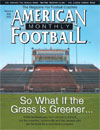AMERICAN FOOTBALL MONTHLY THE #1 RESOURCE FOR FOOTBALL COACHES
Article CategoriesAFM Magazine
|
Room for the Punt ReturnerHow the St. Louis Rams use the vice technique to create space for the punt returnSpecial Teams Coach, St. Louis Rams © More from this issue The goal of the vice technique is to flatten the forcer’s release and keep him from getting vertically down the field. Also, to make him stop his feet and force him to take as much time as possible to get down the field toward the returner. The player to the side of the release is involved in the “stun” phase and technique. The “stun” to the forcer must be physical. The “stun” technique is to attack like making a tackle but without wrapping or grabbing the opponent. The player opposite the release is involved in the “relationship” phase and technique and must work to achieve a “relationship” ....The full article can only be seen by subscribers. Subscribe today!
|
|
|||||||
| HOME |
MAGAZINE |
SUBSCRIBE | ONLINE COLUMNISTS | COACHING VIDEOS |
Copyright 2025, AmericanFootballMonthly.com
All Rights Reserved





